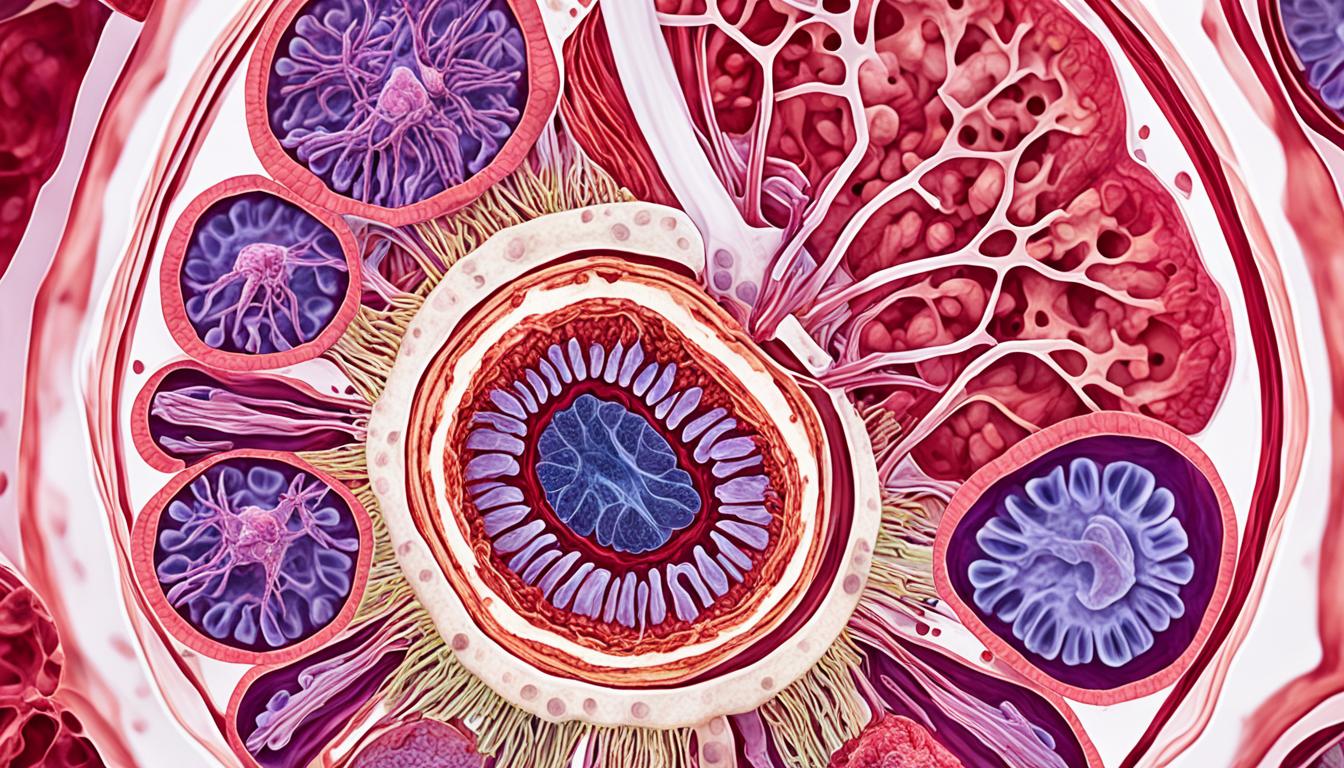Gastrointestinal stromal tumors (GISTs) are the most common tumors in the gut. They come from a group of tumors expressing KIT, a specific protein. These tumors likely start from certain unspecialized cells in the body.
GIST is not very common, occurring in about 10-20 people per million each year. It shows itself differently from person to person. Some may notice a lump or have bleeding. But, figuring out if someone has GIST is often tricky because these signs can be unclear.
For GIST tumors that haven’t spread, the best approach is to remove them with surgery. If they have spread, a medicine called Imatinib can help a lot. Scientists are also looking into how stem cells might be used to fight GIST in the future.
Key Takeaways:
- GISTs are the most common mesenchymal neoplasms of the gastrointestinal tract.
- GISTs are characterized by the expression of KIT and are believed to originate from mesenchymal stem cells.
- The incidence of GIST is estimated to be approximately 10-20 cases per million people per year.
- Common symptoms of GIST include the presence of a mass or bleeding.
- Surgical resection is the mainstay therapy for localized GISTs, while Imatinib has been approved for advanced cases.
- Stem cell therapy is being investigated as a potential treatment option for GISTs.
Epidemiology and Clinical Presentation of GIST
Gastrointestinal stromal tumors (GISTs) are unusual cancers, making up less than 1% of all GI tumors. They mainly affect those over 40. GIST occurs worldwide and doesn’t seem linked to where you live, your ethnicity, race, or job.
The stomach is the most common spot for GISTs, about 50-60% of the time. The small intestine follows closely, with 30-40% of cases. GISTs can also occur in the colon, rectum, esophagus, and other areas. See the chart below for more details:
| Location | Percentage |
|---|---|
| Stomach | 50-60% |
| Small Intestine | 30-40% |
| Colon | 5-10% |
| Rectum | 5-10% |
| Esophagus | 2-5% |
| Extra-gastrointestinal | 2-5% |
GISTs show up differently in each person. Symptoms can include stomach pain, a lump that can be felt, bleeding, sickness, throwing up, feeling full quickly, and losing weight. These signs depend on where the tumor is and its size, which can block or bleed. GISTs are often not found early, so they might have spread when diagnosed.
| Symptoms |
|---|
| Abdominal pain |
| Palpable mass |
| Bleeding |
| Nausea |
| Vomiting |
| Abdominal discomfort |
| Weight loss |
| Early satiety |
Understanding GISTs well is key due to how complex they are. Knowing where they can occur and what to look for helps in finding and treating GIST early. This is vital for the right diagnosis and treatment.
Diagnosis and Treatment Options for GIST
Diagnosing gastrointestinal stromal tumor (GIST) is hard because its symptoms are not very specific. To find out if someone has GIST, doctors often use different tests. These include a barium exam, ultrasound, and a CT scan. Endoscopic ultrasound (EUS) is also helpful. It can tell if a GIST might be cancerous by looking at it closely. A test called immunohistochemistry, or IHC, is key in diagnosing GISTs. It looks for a protein called CD117 (KIT) that is often found in these tumors.
The main treatment for GIST is surgery. The aim is to remove the tumor completely and lower the risk of it breaking open. But, sometimes, after surgery, doctors might use adjuvant therapy. This extra treatment can help a patient even more. Medicines like imatinib and sunitinib are also used. They are called targeted therapies. They have been very successful in helping patients live longer and lowering the chances of the cancer coming back and spreading. Researchers are also studying if stem cell therapy could be another option for treating GISTs.

